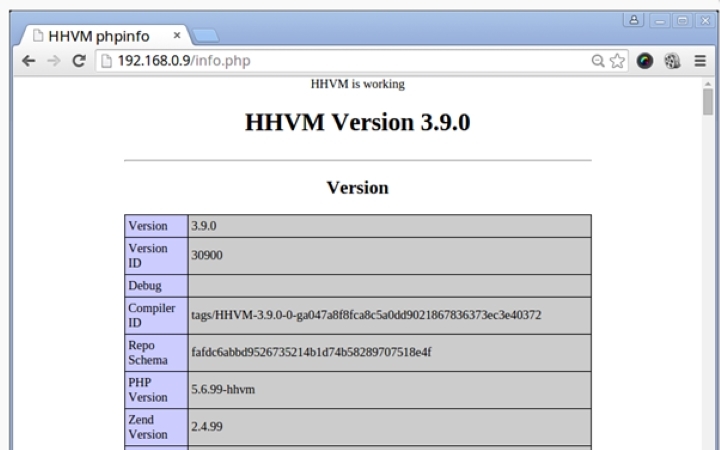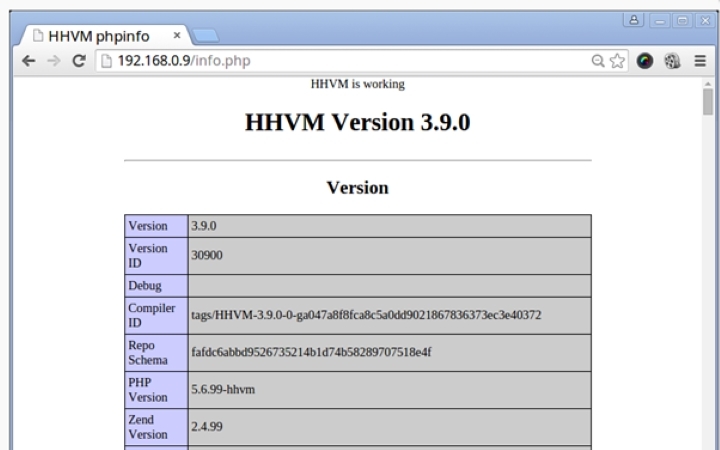
 Data Structure
Data Structure Networking
Networking RDBMS
RDBMS Operating System
Operating System Java
Java MS Excel
MS Excel iOS
iOS HTML
HTML CSS
CSS Android
Android Python
Python C Programming
C Programming C++
C++ C#
C# MongoDB
MongoDB MySQL
MySQL Javascript
Javascript PHP
PHP
- Selected Reading
- UPSC IAS Exams Notes
- Developer's Best Practices
- Questions and Answers
- Effective Resume Writing
- HR Interview Questions
- Computer Glossary
- Who is Who
Setting Up High-Performance ëHHVM\' and Nginx/Apache with MariaDB on Debian/Ubuntu
Setting up high overall performance HHVM (HipHop Virtual Machine) with Nginx, Apache, and MariaDB on Debian or Ubuntu entails configuring an effective internet server stack to optimise the overall performance of internet programmes. HHVM is a just-in-time compiler designed for PHP, resulting in advanced execution speed. Nginx/Apache acts because the internet server software programme manages incoming requests efficiently. MariaDB serves as the database server to keep and manipulate statistics effectively. The system consists of putting in and configuring HHVM, Nginx/Apache, and MariaDB on the Debian/Ubuntu system. HHVM is incorporated with the internet server software programme, allowing the execution of PHP documents through the use of HHVM. Nginx/Apache guarantees the green management of HTTP requests and internet web page serving. MariaDB provides a high-overall performance database backend for statistics storage and retrieval.
By putting in place this high-overall performance stack, internet programmes gain from quicker execution, scalability, and a more suitable user experience, enhancing standard server efficiency. It optimises the overall performance of PHP-primarily based programmes, letting them manage large workloads efficiently.
Methods Used
Standard installation
Custom configuration
Standard Installation
Standard set-up within the context of putting in high-overall performance HHVM and Nginx/Apache with MariaDB on Debian/Ubuntu refers to following the advocated set-up steps furnished with the aid of the respectable documentation of the respective software programme components. This method entails the use of package managers like apt or dnf to put in HHVM, Nginx/Apache, and MariaDB from respectable repositories. It guarantees a truthful and well-documented set-up process, generally consisting of pre-configured default settings.
With a trendy setup, directors can depend on the examined configurations and dependencies furnished with the aid of the software programme developers, minimising the capacity for compatibility issues. While this method might not cater to particular customization needs, it gives a brief and dependable manner to install the high-overall performance stack, permitting internet programmes to enjoy the optimised overall performance and balance of HHVM, Nginx/Apache, and MariaDB.
Algorithm
Begin the process of putting in the high-overall performance stack.
Refer to the legit documentation for HHVM, Nginx/Apache, and MariaDB for the encouraged set-up steps.
Use the correct package manager, together with apt or dnf, to put in HHVM, Nginx/Apache, and MariaDB from the legit repositories.
Follow any extra commands furnished within the documentation, together with configuring repositories or allowing essential modules.
Verify the setup of every aspect with the aid of checking the device's fame or walking model commands.
Start the essential services, together with beginning HHVM, Nginx/Apache, and MariaDB, with the use of systemctl or provider commands.
Configure any required settings or modifications primarily based on the unique necessities of the net software, using the respective documentation for guidance.
Test the capability and overall performance of the high-overall performance stack with the aid of having access to the net software and making sure the right integration among HHVM, Nginx/Apache, and MariaDB.
Monitor device resources, logs, and overall performance metrics to ensure the most efficient operation and deal with any troubles that can arise.
Document the set-up system and configuration information for future reference and troubleshooting.
Output

Custom Configuration
Custom configuration, within the context of putting in excessive-overall performance HHVM and Nginx/Apache with MariaDB on Debian/Ubuntu, refers back to the procedure of fine-tuning the configuration settings of every aspect to optimise overall performance primarily based on particular utility requirements. It includes making modifications to diverse parameters and alternatives to improve useful resource usage and enhance normal device efficiency.
For example, custom configurations can also consist of allocating suitable reminiscence limits for HHVM, optimising Nginx and Apache settings inclusive of concurrent connections and caching mechanisms, and tuning MariaDB parameters inclusive of question caching and buffer sizes. By tailoring those configurations to suit the workload and needs of the utility, directors can maximise overall performance, decrease reaction times, and reap excessive scalability, ensuring an optimised and responsive net server stack.
Algorithm
Identify the precise overall performance necessities and desires of your application.
Begin the custom configuration procedure by having access to the configuration documents of HHVM, Nginx/Apache, and MariaDB.
Analyse the to-be-had configuration alternatives and parameters for every component, relating to their respective documentation.
Adjust the memory limits for HHVM primarily based on the predicted workload and available device resources.
Fine-song Nginx/Apache settings, which include a wide variety of concurrent connections, timeouts, and caching mechanisms, optimise overall performance.
Review and optimise MariaDB configuration parameters, inclusive of question caching, buffer sizes, and indexing, to enhance the database's overall performance.
Continuously display the device's overall performance through the use of overall performance tracking equipment and modify configurations as needed.
Conduct benchmarking and cargo testing to evaluate the effect of custom configurations and make similar refinements if necessary.
Document the custom configurations for future reference and keep a record of the adjustments made.
Output

Conclusion
This article affords guidance on putting in a high-overall performance stack comprising HHVM, Nginx/Apache, and MariaDB on Debian/Ubuntu. It explores the system of putting in and configuring those additives to optimise the overall performance of net packages. The article covers two approaches: well-known setup and custom configuration. The well-known set-up approach follows encouraged steps from reputable documentation, making sure a dependable and simple setup. The custom configuration method specialises in fine-tuning settings to fulfil particular utility requirements. By imposing this high overall performance stack, net packages can benefit from advanced execution speed, scalability, and a better user experience. The article aims to empower readers to set up an optimised network server environment on Debian or Ubuntu.

